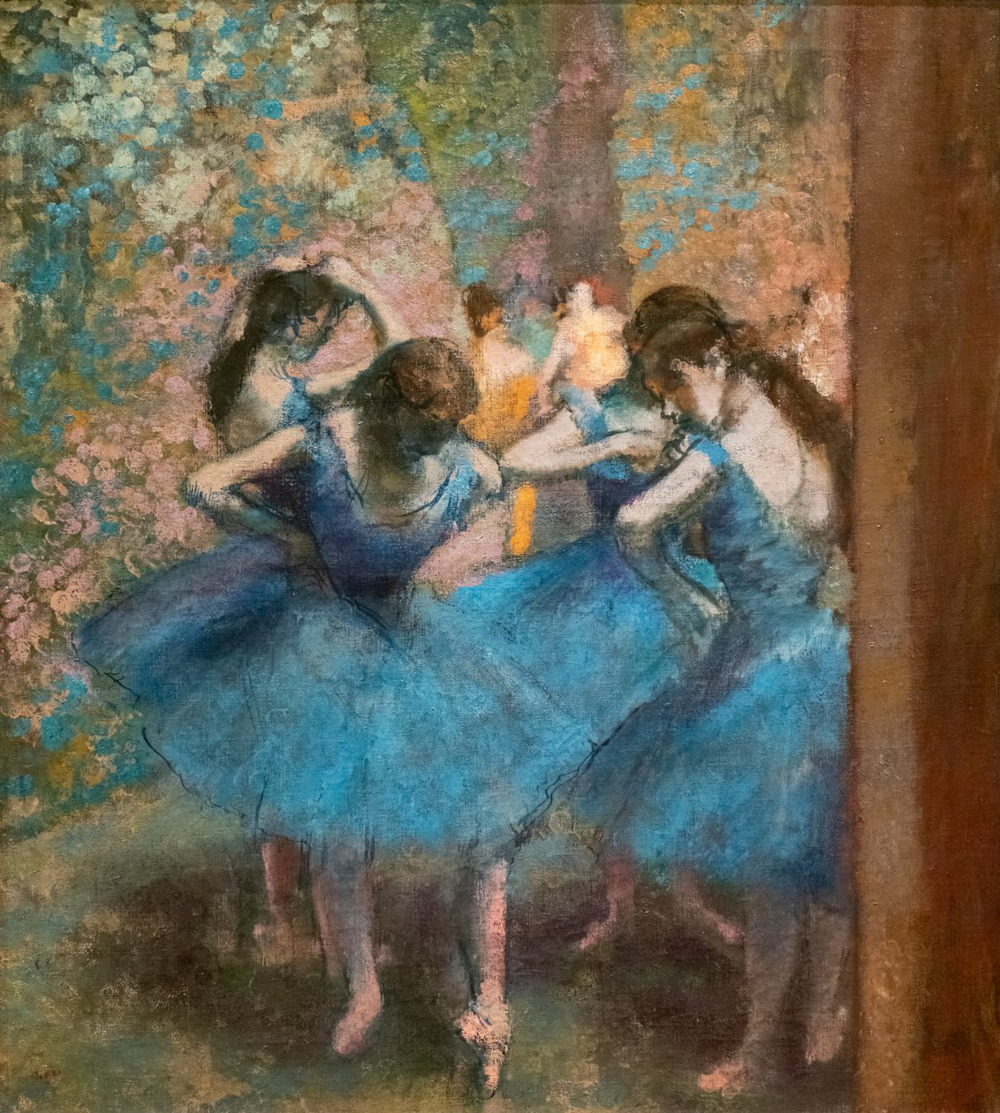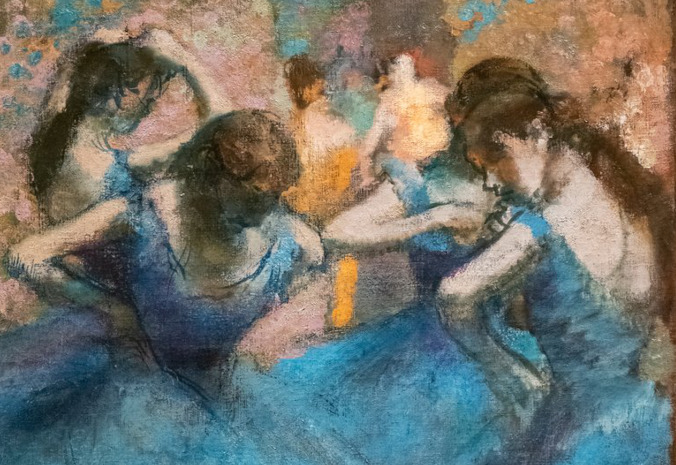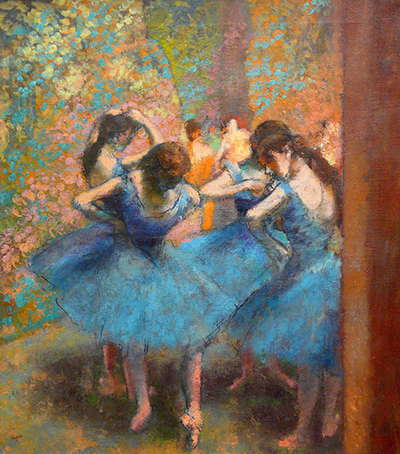Blue Dancers, sometimes referred to as Dancers in Blue, arrived in 1890.
It is amongst the most famous Edgar Degas ballet dancer paintings.
Introduction
French artist, Edgar Degas, moves his focus away from nude women bathing (as evident within his painting After The Bath), towards a more innocent approach by portraying young ballerinas. Degas is primarily known for his work in painting ballerinas.
Yet, the artist still was able to create a wide array of paintings in different styles of ballet to keep his audience interested. The painting, Blue Dancers, belongs to 1 of over 200 oil on canvas paintings Edgar Degas has created.
Ballerinas were one of the artist's favourite subjects, as they showcase an element of the artist's character in his love for the allure of the rhythmic dance. The Blue Dancers are one of the only paintings by Degas where the artist opted for cool tones in order to depict the women.
Inspiration
While Degas felt that his artwork captured a moment in time, it is believed that his lust towards ballet was based on the natural movement of the human body, and even paintings could still capture its beautiful form. While Degas has painted ballerinas throughout most of his career, Blue Dancers was painted towards the end.
Painting Description
The stunning piece of work illustrates four ballerinas in lavender-blue dancing among one another in a recital. Each figure curves their body in their own way turning their face from one another as they focus on their dance. The top right figure curves her arms towards her as she looks to her left slightly analyzing her partner.
Her partner stands out from the other ballerina as she is the only blonde upon the group of brunettes. Her left hand is extended towards the heavens while her right arm is folded as the palm of her hand rests upon her heart.
The third ballerina holds her arms folded onto her shoulders as she extends her head and looks towards the ground. Alongside, the final ballerina bends with her face towards the ground as her body is cut out of the frame. All four ballerinas are drenched in deep blue lavender dresses as they stand around one another.
Yet, even while the painting does not show case the exact movement of the women, the viewer is able to tell their actions are in harmony based on the brief glimpse of their frozen bodies. Similar soft styles to this artwork are evident within famous French artist Claude Monet.
Even while the figures are still, the artist held the gift to still be able to showcase them in a natural form in sync with one another, creating a work of art through their body. The ruffles of their dress fall off their shoulders exposing their bare skin, a characteristic Degas loves to include within his work as evident within his other painting Group of Dancers.
Technique
Degas uses an expressive style of painting to showcase the ruffles of the dresses and the background of the painting. The artist simply masses the figures together as the shades blend into each other. The bold colours differ from one another yet still manage to unify the painting as glimpses of blue are found throughout the piece.
The background of the artwork is based on hues of orange and green, as if the painting was set outside. Small touches of blue are used to bring in the background to the colour scheme of the ballerina's costumes.
Colour is the essential element of the artwork as the bright shades grasp the viewer's attention. While the colours remain incredibly bold, the artist uses a dark grey to contour the backs of the ballerinas to add depth to the painting rather than bold figures.
This shading allows for the viewer to witness the light source coming from the top of the painting, as if an actual sun is shining onto the skin of the young women. Edgar Degas was successful in using a cooler toned blue and lavender to portray his most desired muse, ballerinas.
Later in his career, Degas had altered his portraiture style, with this being amongst his finest from that period. This artwork features a favoured composition for Degas in the formation of his modelling ballerinas.
He would continue this method of grouping dancers throughout the 1890s, constantly experimenting with colour upon the same theme. There was another painting titled Blue Dancers which is included here. Artist Degas would typically paint or sketch in the same direction as his ballerinas would stretch and twist. He discovered this technique ensured a greater lifelike depiction.
Dancers in Blue
Dancers in Blue, 1890 was one of his later ballet dancer paintings. By this stage he had moved away from some of his artistic choices for his dancers that he used earlier in his career. For example, he would include content around the individual dancer's backgrounds and also the angles from which they may be viewed in the crowd.
By this stage, his dancers would lose their individuality and the backdrops used would be subtler and generic. By now he would also increasingly work from memory and was not as frequent a visitor to the Opera as he had been.
Further Ballerina Paintings by Degas
Dancers in Blue, Blue Dancers and Green Dancer all make use of his symbolist work, with a cool dominant tone based around blues or greens. Degas frequently returned to these colours throughout his different ballerina series.
It was Venetian artists whose influence brought in warmer tones for some of his other ballerina paintings. His time studying in Italy had left an imprint on his work that lasted throughout his life. By the late 1890s Degas became more respected and more confident as a result.
This enabled him to draw in a greater experimentation into this theme of his work. Dancers, 1898, underlines this with a loosely rendered view of ballerinas preparing to dance backstage.
By the turn of the century, Degas' eyesight was significantly deteriorating. His style again changed, to a more colourful palette similar to Fauvists of that time. He also reduced detail, approaching an abstract form that he would have found easier to produce bearing in mind his health issues.
As a keen art collector, some from his own collection may have provided this inspiration for bright colour. Gauguin was there, with Matisse also someone he admired.
Large Image of Blue Dancers by Edgar Degas
 Blue Dancers by Edgar Degas
Blue Dancers by Edgar Degas
 Ballerinas in Blue Detail by Degas
Ballerinas in Blue Detail by Degas




